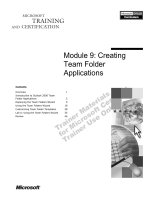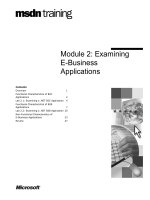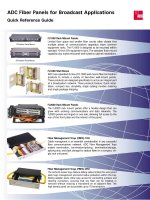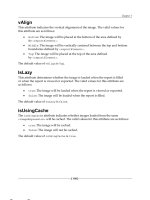Tài liệu Enterprise J2ME: Developing Mobile Java Applications pptx
Bạn đang xem bản rút gọn của tài liệu. Xem và tải ngay bản đầy đủ của tài liệu tại đây (5 MB, 1,259 trang )
Enterprise J2ME: Developing Mobile
Java Applications
Table of Contents
Copyright
About Prentice Hall Professional
Technical Reference
Foreword
About this Book
Target Audience
Prerequisites
Contents
Code Examples
Commercial Products
Related Publications
Production Notes
Acknowledgments
Part I: Introduction
Chapter 1. Mobile Commerce: Visions,
Realities, and Opportunities
1.1 Mobile Commerce Value Propositions
1.2 Mobile Technology Adoption
1.3 The Search for Killer Mobile
Applications
1.4 Mobile Commerce Landscape
1.5 Summary
Resources
Chapter 2. J2ME: Is Mobile Java Ready
for Enterprise?
2.1 Why Java?
2.2 The Java Community Process
2.3 Java Everywhere
2.4 Java 2 Micro Edition Explained
2.5 Competing Technologies
2.6 Summary
Resources
Part II: End-to-End Enterprise
Applications
Chapter 3. The Smart Client Paradigm:
iFeedBack
3.1 Benefits of Smart Clients
3.2 Introducing iFeedBack
3.3 iFeedBack Usage Scenarios
3.4 Implementation Walk Through
3.5 Summary
Resources
Chapter 4. Managed Smart Clients
4.1 Container-Managed Applications
4.2 OSGi Containers
4.3 A Simple Echo Service Example
4.4 Smart Client with HTTP Front End
4.5 Mobile Gateways
4.6 Summary
Resources
Chapter 5. Mobile Design Patterns: The
Smart Ticket Blueprint
5.1 Getting Started
5.2 Smart Ticket in Action
5.3 Important Architectural Patterns
5.4 Implementation Techniques
5.5 Summary
Resources
Chapter 6. Advanced HTTP Techniques
6.1 The Decorator Approach
6.2 The Process-Chain Approach
6.3 Session Tracking via HTTP Cookies
6.4 HTTP Basic Authentication
6.5 HTTP Digest Authentication
6.6 Secure HTTP
6.7 Summary
Resources
Chapter 7. End-to-End Best Practices
7.1 Limited Device Hardware
7.2 Slow, Unreliable Networks
7.3 Pervasive Devices
7.4 Ubiquitous Integration
7.5 The Impatient User
7.6 Summary
Resources
Part III: Mobile Messaging Applications
Chapter 8. Email and PIM
8.1 Basics of Email
8.2 Introducing Mail4ME
8.3 The JavaPhone API
8.4 The PDA Optional Package
8.5 Commercial Email and PIM Suites
8.6 Corporate Portal Servers
8.7 Summary
Resources
Chapter 9. Converged Mobile P2P
Messaging
9.1 Introducing the Wireless Messaging
API
9.2 WMA in Action
9.3 WMA Reference Implementation
9.4 SMS from the Back End
9.5 Beyond SMS: The IM Convergence
9.6 SIP-Based IM Applications
9.7 Summary
Resources
Chapter 10. Enterprise Messaging
10.1 Mobile Enterprise Messaging
10.2 Introducing the JMS
10.3 Mobile JMS from iBus//Mobile
10.4 The IBM WebSphere MQ
Everyplace
10.5 Summary
Resources
Part IV: Mobile Databases and
Synchronization Engines
Chapter 11. Mobile Database for CDC
Devices
11.1 Database on the Go
11.2 Introducing JDBC
11.3 Portable and Efficient Code Using
PreparedStatement
11.4 Access Stored Procedures Using
CallableStatement
11.5 The JDBC Optional Package for the
CDC
11.6 HSQL Database Engine
11.7 iAnywhere Solutions SQL Anywhere
Studio
11.8 IBM DB2 Everyplace
11.9 Oracle9i Lite
11.10 PointBase Micro Edition
11.11 Example Application: Contact
Manager
11.12 Summary
Resources
Chapter 12. Mobile Databases for MIDP
Devices
12.1 PointBase Micro Edition
12.2 The Oracle J2ME SODA SDK
12.3 The IBM DB2e FastRecordStore
12.4 Summary
Resources
Chapter 13. Database Synchronization
13.1 Synchronization and Mobility
13.2 PointBase UniSync
13.3 IBM DB2 Everyplace
13.4 iAnywhere Solutions MobiLink
13.5 Oracle9i Mobile Server
13.6 The Synchronized Contact Manager
13.7 Summary
Resources
Chapter 14. Access Backend Databases
14.1 Direct Access to Remote Databases
14.2 The Oracle J2ME SQL SDK
14.3 Legacy Applications
14.4 Using Simplicity for Legacy
Databases
14.5 Summary
Resources
Part V: XML and Mobile Web Services
Chapter 15. XML for Small Devices
15.1 What Is XML?
15.2 Challenges for Small Devices
15.3 XML Parsing Models
15.4 Introducing Amazon XML Services
15.5 Amazon Services via XmlPull
15.6 Amazon Services via kDOM
15.7 A Mobile RSS Client
15.8 Summary
Resources
Chapter 16. SOAP Web Services on
Smart Clients
16.1 What Is SOAP Web Services?
16.2 Introducing kSOAP
16.3 kSOAP Explained
16.4 Advanced kSOAP
16.5 More kSOAP Examples
16.6 What's in kSOAP v2.0?
16.7 Summary
Resources
Chapter 17. The J2ME Web Services
Optional Package
17.1 A Little History
17.2 The XML Processing API
17.3 The JAX-RPC API
17.4 The SPI for Implementers
17.5 Compare with kXML and kSOAP
17.6 Summary
Resources
Chapter 18. Case Study: Mobile Clients
for Location-Based Services
18.1 Location-Based Services
18.2 Microsoft MapPoint Web Services
18.3 MapPoint J2ME Clients
18.4 Enhancing the Driving Directions
Application
18.5 Summary
Resources
Part VI: Advanced Mobile Security
Chapter 19. Mobile Security for
Enterprise
19.1 What Is Advanced Mobile Security?
19.2 Lightweight Mobile Cryptography
Toolkits
19.3 Bouncy Castle Lightweight API
19.4 The IAIK ME JCE
19.5 Phaos Technology Micro Foundation
Toolkit
19.6 NTRU jNeo for Java Toolkit
19.7 B3 Security
19.8 Device-Specific APIs
19.9 Standardization of J2ME Security
APIs
19.10 Summary
Resources
Chapter 20. The J2ME Crypto Recipes
20.1 Overview of Recipes
20.2 Symmetric Encryption
20.3 Password-Based Encryption
20.4 Public Key Encryption
20.5 Digital Signature
20.6 Summary
Resources
Appendix A. Basics of J2ME Application
Development
A.1 Life Cycle Methods
A.2 UI Model
A.3 Remote and Local Data
A.4 Code Walk Through
A.5 Packaging and Building
A.6 Deployment
A.7 Summary
Appendix B. Tools and J2ME Runtimes
for PDAs
B.1 Overview of the WebSphere Studio
Device Developer
B.2 Installing MIDP on PocketPC Devices
B.3 Installing Personal Profile on
PocketPC Devices
B.4 Run Java Applications on the
PocketPC Device
B.5 Summary
Enterprise J2ME: Developing Mobile Java
Applications
By Michael Juntao Yuan
Publisher : Prentice Hall PTR
Pub Date : October 23, 2003
ISBN : 0-13-140530-6
Pages : 480
Slots : 1.0
J2ME offers an extraordinarily flexible and robust platform
for developing mobile applications with enterprise-class
performance, reliability, and value. Now, leading mobile
•
Table of
Contents
developer Michael Yuan covers every aspect of building
industrial-strength applications with J2ME: design,
architecture, tools, processes, business issues, and more.
Yuan introduces innovations that make the platform even
more powerful, ranging from new J2ME profiles and
wireless messaging APIs to mobile databases and web
services tools. These innovations allow existing Java(TM)
developers (especially J2EE(TM) developers) to leverage
their skills and add mobility to enterprise applications.
Yuan also presents more than a dozen complete sample
applicationsincluding the application that earned him the
grand prize in Nextel, Sun, and Motorola's nationwide
wireless developer contest. Coverage includes:
Patterns and best practices for building end-to-end
mobile applications
Emerging mobile "killer applications": driving
productivity and cost reduction
"Smart client" applications: architecture and
construction
Advanced HTTP techniques for authentication and
session tracking
Overcoming hardware and network limitations
Leading-edge mobile enterprise messaging techniques
Mobile databases and synchronization engines
XML and mobile web services, including the J2ME
Web Services Optional Package
New options for mobile security in the enterprise
•
Table of
Contents
Enterprise J2ME: Developing Mobile Java
Applications
By Michael Juntao Yuan
Publisher : Prentice Hall PTR
Pub Date : October 23, 2003
ISBN : 0-13-140530-6
Pages : 480
Slots : 1.0
Copyright
About Prentice Hall Professional Technical Reference
Foreword
About this Book
Target Audience
Prerequisites
Contents
Code Examples
Commercial Products
Related Publications
Production Notes
Acknowledgments
Part I: Introduction
Chapter 1. Mobile Commerce: Visions, Realities, and
Opportunities
Section 1.1. Mobile Commerce Value Propositions
Section 1.2. Mobile Technology Adoption
Section 1.3. The Search for Killer Mobile Applications
Section 1.4. Mobile Commerce Landscape
Section 1.5. Summary
Resources
Chapter 2. J2ME: Is Mobile Java Ready for Enterprise?
Section 2.1. Why Java?
Section 2.2. The Java Community Process
Section 2.3. Java Everywhere
Section 2.4. Java 2 Micro Edition Explained
Section 2.5. Competing Technologies
Section 2.6. Summary
Resources
Part II: End-to-End Enterprise Applications
Chapter 3. The Smart Client Paradigm: iFeedBack
Section 3.1. Benefits of Smart Clients
Section 3.2. Introducing iFeedBack
Section 3.3. iFeedBack Usage Scenarios
Section 3.4. Implementation Walk Through
Section 3.5. Summary
Resources
Chapter 4. Managed Smart Clients
Section 4.1. Container-Managed Applications
Section 4.2. OSGi Containers
Section 4.3. A Simple Echo Service Example
Section 4.4. Smart Client with HTTP Front End
Section 4.5. Mobile Gateways
Section 4.6. Summary
Resources
Chapter 5. Mobile Design Patterns: The Smart Ticket Blueprint
Section 5.1. Getting Started
Section 5.2. Smart Ticket in Action
Section 5.3. Important Architectural Patterns
Section 5.4. Implementation Techniques
Section 5.5. Summary
Resources
Chapter 6. Advanced HTTP Techniques
Section 6.1. The Decorator Approach
Section 6.2. The Process-Chain Approach
Section 6.3. Session Tracking via HTTP Cookies
Section 6.4. HTTP Basic Authentication
Section 6.5. HTTP Digest Authentication
Section 6.6. Secure HTTP
Section 6.7. Summary
Resources
Chapter 7. End-to-End Best Practices
Section 7.1. Limited Device Hardware
Section 7.2. Slow, Unreliable Networks
Section 7.3. Pervasive Devices
Section 7.4. Ubiquitous Integration
Section 7.5. The Impatient User
Section 7.6. Summary
Resources
Part III: Mobile Messaging Applications
Chapter 8. Email and PIM
Section 8.1. Basics of Email
Section 8.2. Introducing Mail4ME
Section 8.3. The JavaPhone API
Section 8.4. The PDA Optional Package
Section 8.5. Commercial Email and PIM Suites
Section 8.6. Corporate Portal Servers
Section 8.7. Summary
Resources
Chapter 9. Converged Mobile P2P Messaging
Section 9.1. Introducing the Wireless Messaging API
Section 9.2. WMA in Action
Section 9.3. WMA Reference Implementation
Section 9.4. SMS from the Back End
Section 9.5. Beyond SMS: The IM Convergence
Section 9.6. SIP-Based IM Applications
Section 9.7. Summary
Resources
Chapter 10. Enterprise Messaging
Section 10.1. Mobile Enterprise Messaging
Section 10.2. Introducing the JMS
Section 10.3. Mobile JMS from iBus//Mobile
Section 10.4. The IBM WebSphere MQ Everyplace
Section 10.5. Summary
Resources
Part IV: Mobile Databases and Synchronization Engines
Chapter 11. Mobile Database for CDC Devices
Section 11.1. Database on the Go









